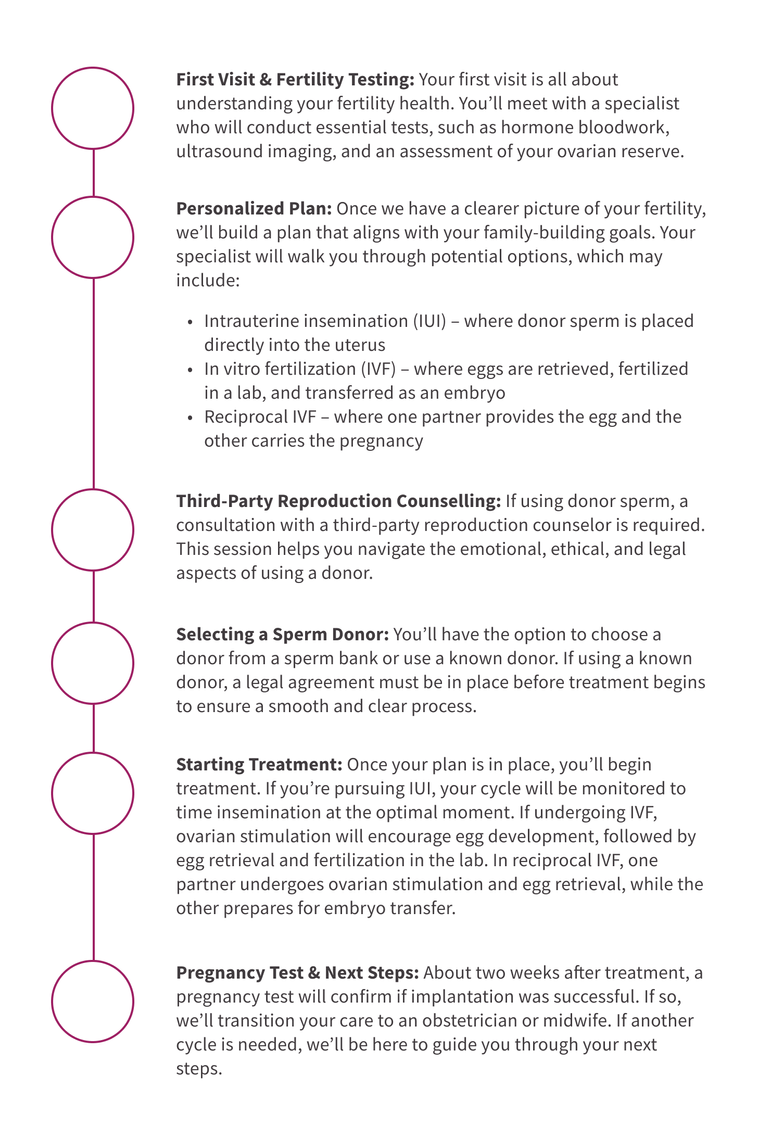Fertility Care Options for 2SLGBTQIA+ Families
Bringing a baby into your life is deeply meaningful. We’re here to support and guide you every step of the way.
Start with expert guidance to help you navigate with clarity and care.
Helping LGBTQ2SIA+ families grow
We are committed to providing
inclusive, affirming, and knowledgeable
fertility care for the 2SLGBTQIA+ community.
Everyone deserves the chance to grow their family in a space where they feel respected, supported, and understood.
Here’s how we ensure inclusive, affirming care:
Inclusive and Diverse Team – Our fertility care team reflects the diversity of the community we serve, fostering a safe and welcoming space.
Ongoing Education – Our teams receive continuous training on gender and sexual diversity, so every interaction is met with sensitivity and care.
Gender-Affirming Care – We support individuals on gender-affirming hormones who are seeking to conceive or preserve their fertility, providing guidance tailored to their unique needs.
Third-Party Reproduction Expertise – Whether you’re exploring donor sperm, egg donation, reciprocal IVF, or surrogacy, our team is here to guide you through the process with experience and care.
Thoughtful Clinic Spaces – Our spaces are designed with inclusivity in mind, offering both gendered and gender-neutral washrooms for comfort and accessibility.
No matter what your path to parenthood looks like, you deserve care that is affirming, knowledgeable, and compassionate. We’re here to support you—every step of the way.
2SLGBTQIA+ Pathways to Parenthood
Growing your family starts with a few key elements: healthy eggs, healthy sperm, a receptive uterus, and a plan that fits your needs. For 2SLGBTQIA+ individuals and couples, this may involve third-party reproduction, such as donor eggs or sperm, gestational surrogate, or reciprocal IVF.
Every path is unique, but to help illustrate the process, we’ve outlined two possible journeys—one for female-only families (assigned female at birth) and one for male-only families (assigned male at birth). No matter your path, our team is here with expertise, guidance, and support every step of the way.
For families where one or more partners produce eggs, the path to parenthood may involve intrauterine insemination (IUI), in vitro fertilization (IVF), or reciprocal IVF (where one partner provides the egg, and the other carries the pregnancy).
Here’s what the process typically includes:

Throughout the process, our team will be by your side, offering guidance, support, and compassionate care every step of the way.
For families where one or more partners produce sperm, building a family typically involves egg donation, IVF, and a gestational carrier (surrogate).
Here’s what the process may look like:
1. First Visit & Fertility Testing: Your first appointment is all about understanding your reproductive health. You’ll meet with a specialist for semen analysis, which evaluates sperm count, motility, and overall quality. These insights help determine the best approach for moving forward.
2. Personalized Plan: Once your test results are ready, you’ll meet with your fertility specialist to create a customized plan, which may include egg donation, embryo creation, and working with a gestational carrier.
3. Third-Party Counselling: If using an egg donor and/or gestational carrier, you’ll meet with a third-party reproduction counselor to discuss the legal, ethical, and emotional aspects of the process.
4. Egg Donor Selection: You’ll have the option to choose an egg donor from an egg bank, a known donor, or a fresh donor agency. If using a known donor or fresh egg agency, legal agreements must be in place before treatment begins.
5. Creating Embryos with IVF: Once donor eggs are secured, IVF is used to fertilize them with sperm from one or both partners. The resulting embryos are carefully monitored in the lab, and if multiple embryos develop, they can be frozen for future use.
6. Gestational Carrier Match: If you are using a gestational carrier, your next step is finding a match. This may be through an agency or an identified carrier, and legal agreements will be required before proceeding.
7. Embryo Transfer: A selected embryo is transferred to the gestational carrier’s uterus in a carefully monitored procedure. This step is designed to optimize implantation and increase the chances of a successful pregnancy.
8. Pregnancy Test & Transition to Prenatal Care: About two weeks after the embryo transfer, your gestational carrier will take a pregnancy test. If successful, they will transition to care with an obstetrician or midwife, while you continue receiving support from our team as you prepare to welcome your child.
Throughout the process, our team will be by your side, offering guidance, support, and compassionate care every step of the way.
Resources For 2SLGBTQIA+ Families
Sherbourne Health LGBTQ Parenting Workshops
These in-person and virtual workshops provide information on the practical, emotional, social, and legal aspects of surrogacy, adoption, or pregnancy for 2SLGBTQIA+ families.
Law Firms Specializing in Third Party Reproduction
A fertility lawyer can help you navigate third-party reproductive law in Canada. They help draft and negotiate egg, sperm, embryo donor and surrogacy agreements.
Sherry Levitan
Fertility Lawyer in Toronto
Support for Single Parents By Choice
Every Path to Parenthood is Beautiful
We believe everyone deserves the chance to build a family, no matter their sexual orientation, gender identity, or family structure. Your journey is special, and we’re here to support it with unwavering care, expertise, and respect.


